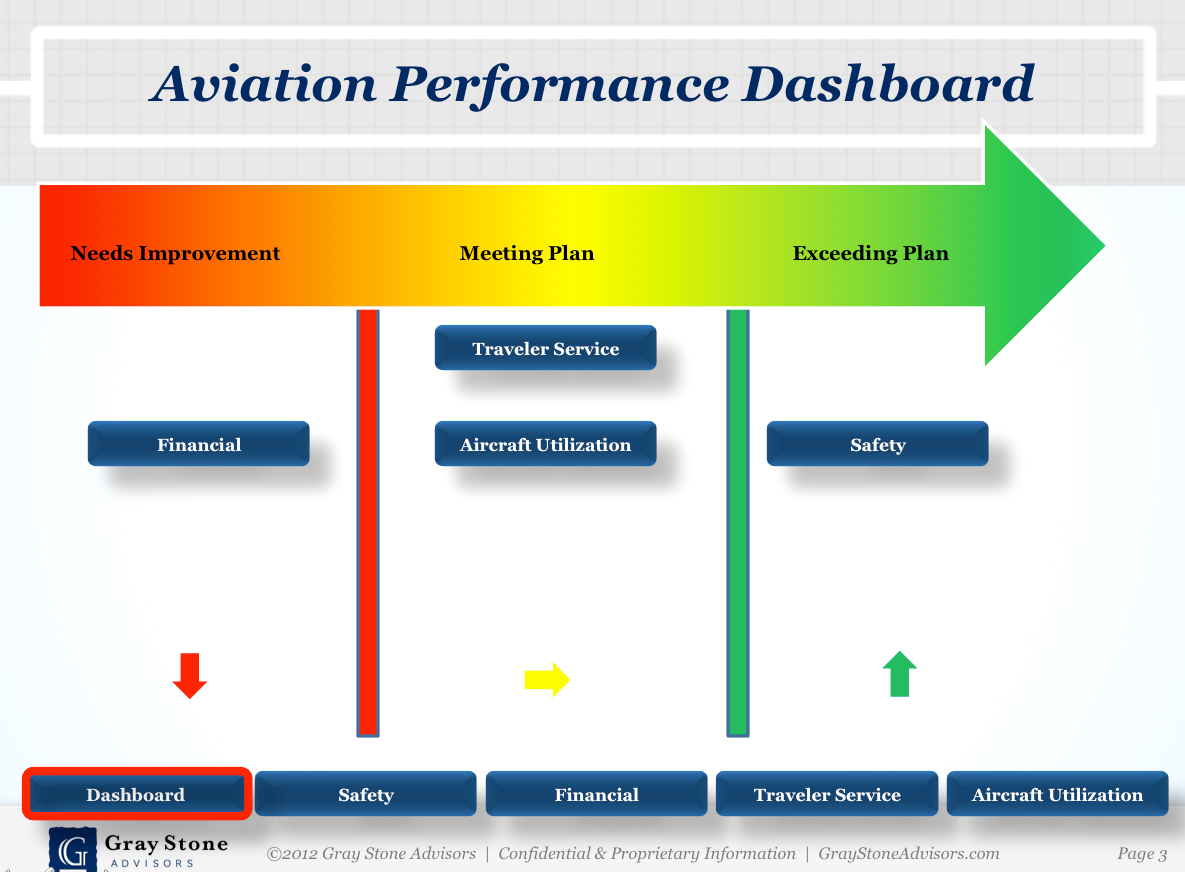Hewlett-Packard’s flight department needed to become more efficient due to changes in the economy. And they needed to deliver more with less budget and headcount.
So when Rich Walsh, HP’s former head of aviation, was given more assignments and less capacity to function in each area of responsibility, he turned to Gray Stone Advisors.
Metrics Dashboard
After an in-depth review of HP’s organization, the result was the creation of an Aviation Performance Metrics Dashboard .
The purpose of this tool was to give Walsh and the department’s reporting executive a better way to present to HP’s top leaders what was happening with the business aviation operations.
“Our performance dashboard allows us to measure and demonstrate the effectiveness of our strategy to corporate,” explains Rich Walsh, HP’s director of aviation and global resiliency. ”
This was never really measured, nor demanded, by corporate. But that changed a couple of years ago so now we’re in a position to demonstrate our effectiveness around some pretty expensive assets and personnel in a timely fashion now.”
Metrics Package Identifies Strategic Activities, Delivers Value
The benefits of measuring and reporting on flight department metrics, according to Walsh, include the ability to:
Operate more independently, more seamlessly and become more transparent in the different areas of responsibility.
Free up team members’ capacity so they can focus more on hidden risks.
Align with existing corporate requirements with regard to reporting on costs and processes.
Recognize strategic activities that team members were already performing such as boosting efficiency by consolidating trips whenever possible.
Spotlight ways to reduce expenses, which equates to hundreds of thousands of dollars of savings to corporate.
Create strategic alignment with corporate requirements in terms of expense and process reporting.
Provide aviation teams with a framework to help them better forecast trends with the aircraft, align their processes, and become more collaborative in their approach.
Aviation Best Practices Spread Throughout HP
As metrics standards were introduced to the HP Reporting Executive who oversees the aviation department as well as other corporate support functions, Gray Stone’s measurement and tracking dashboard tool has now become a metrics standards for HP.
While HP’s business units measure outcomes unique to their department’s goals and needs, there is now a commonality in how things get measured, how the data get reported and how value is determined.
These are all common philosophies being utilized in multiple areas at HP.
Where Can Your Flight Department Start?
Since each flight department is unique, it’s important to experiment until you get it right. And then tweak from there.
HP’s metrics dashboards evolve. So it doesn’t look anything like it did the first day that we introduced the concept. They continue to grow and develop every month.
Here are three tips to get started when implementing a metrics program in your flight department:
1. Know your data.
There are countless sources for accumulating operational and flight department data. You can get key information from scheduling software, from finance and accounting software (e.g., Oracle and SAP); your Safety Management System (SMS); and FOQA, avionics and FADEC software.
You can even manually track data the old fashioned way. The key is to know what data you’re already collecting, what the various mediums are that house the data and how often you need to capture this information.
2. Get aligned with corporate.
A flight department cannot possibly have the bandwidth to track and report on every metric. But the key to creating efficiency is to align with needs of the host organization and report on the top 3-5 priorities (e.g., financials, aircraft utilization, safety performance, traveler services).
Keeping things simple at first will help you get started and gain traction. The goal is to whet the appetite of the senior leaders and give them useful information to make better, more informed business decisions.
3. Track regularly.
Once you know where your data is and what you’d like to capture, the challenge then becomes creating a reporting system that provides the information in an automated way, and on a regular basis.
Gray Stone’s clients receive monthly reports, which helps keep the senior leadership team abreast of the corporation’s ability to hit their designated targets.
Walsh is well satisfied with Gray Stone’s services. “We’re a lean flight department and[metrics] is just one of the offerings that we use from Gray Stone. We have a complex, demanding operation, and I have to have a strategic partner who has multi-faceted offerings that I can use, and it’s been an effective solution for us at HP.”
Excerpts from this Metrics Dashboard case study originally appeared in Aviation International News article, Dashboarding the HP Way, by Matt Thurber.
